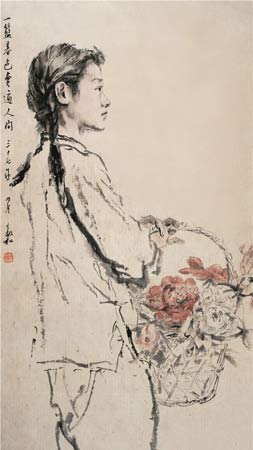Figure paintings build on rich Chinese traditions
Author : Li Yiyi Source : Chinese Social Sciences Today 2016-09-27

The picture shows the figure painting A Flower Girl created in 1948 by Jiang Zhaohe (1904-86), one of the pioneers and founders of modern Chinese ink figure painting in the 20th century.
Chinese figure painting emerged as a serious art form in the Han and Tang dynasties and began to decline in the Yuan Dynasty (1271-1368). Then in the 20th century, modernization drove a revival in the art, which is believed to be due to an increased emphasis on realism.
An academic exhibition titled “light of reality” was recently featured at the China Arts Museum in Shanghai. Nearly 300 contemporary Chinese figure paintings were on display, including works from 20th century masters. The exhibition charted the development of this traditional Chinese art form in a comprehensive manner.
Arguably the most significant achievement of contemporary Chinese figure paintings was the creation of realistic ink figure paintings. Xu Beihong and Jiang Zhaohe are the undisputed masters in this regard. Xu Beihong created realist ink paintings in the 1930s, and a large number of painters took the same trajectory after the founding of the People’s Republic of China.
In North China, the school represented by Xu Beihong and Jiang Zhaohe focuses on the realistic figure images. However, the southern Chinese approach, represented by artists from the China Academy of Art in Zhejiang Province, emphasizes the charms of ink paintings based on Chinese aesthetics. Fang Zengxian was the pioneer of this form. In his 2005 work Old Man with Velvet Hat, the figure was wrapped in a frock and buried in thought. The work was considered a success among ink paintings.
In addition to painting practices, a thin book named How to Draw Ink Figure Paintings by Fang Zengxian offered advice on techniques in ink paintings. The book integrated Western features and Eastern traditions, which influenced a batch of painting masters including Liu Wenxi, Zhou Sicong and Lu Chen. At the same time, it led to a new pattern connecting the north and south.
In the 1980s, realistic Chinese painting was influenced by Western contemporary arts. Painters began to give up realistic techniques and instead they adopted twisted and exaggerated styles to express subjective feelings. The exhibition, Figure of Minors, by Zhou Sicong, is representative of expressionism. It had a huge impact by using dry and dark ink in painting twisted and hard images.
Urban themes are drawing increasing attention as people experience convenience alongside ennui in cities. Huge Bus, by Li Xiaoxuan, reflects urbanite’s anxieties in a scene in which more than 100 people are crowded onto a double-decker bus.
The responsibility of contemporary painters is to convey human drives and the pressure from society, along with human respect for life. Contemporary figure paintings can create brilliant portrayals of this era, said Shi Dawei, executive dean of the Shanghai Chinese Painting Academy.
Ye Shengtao made Chinese fairy tales from a wilderness
Ye Shengtao (1894–1988) created the first collection of fairy tales in the history of Chinese children’s literature...
-
How northern ethnicities integrated into Chinese nation
2023-09-18
-
Mogao caves
2023-09-12
-
Mogao Grottoes as ‘a place of pilgrimage’
2023-09-12
-
Time-honored architectural traditions in China
2023-08-29
-
Disentangling the civilizational evolution of China
2023-08-28
-
AI ethics in science fiction
2023-08-23














 2011-2013 by www.cssn.cn. All Rights Reserved
2011-2013 by www.cssn.cn. All Rights Reserved